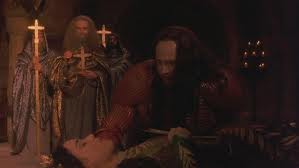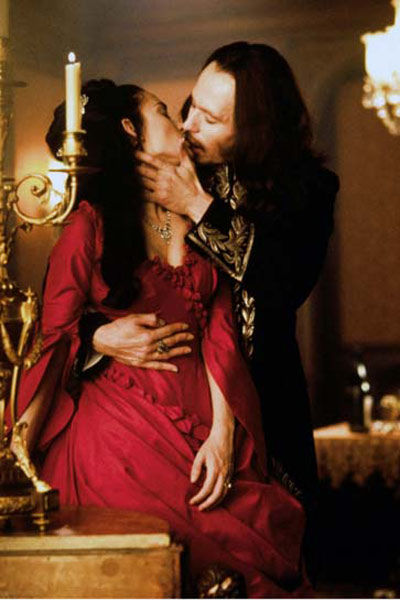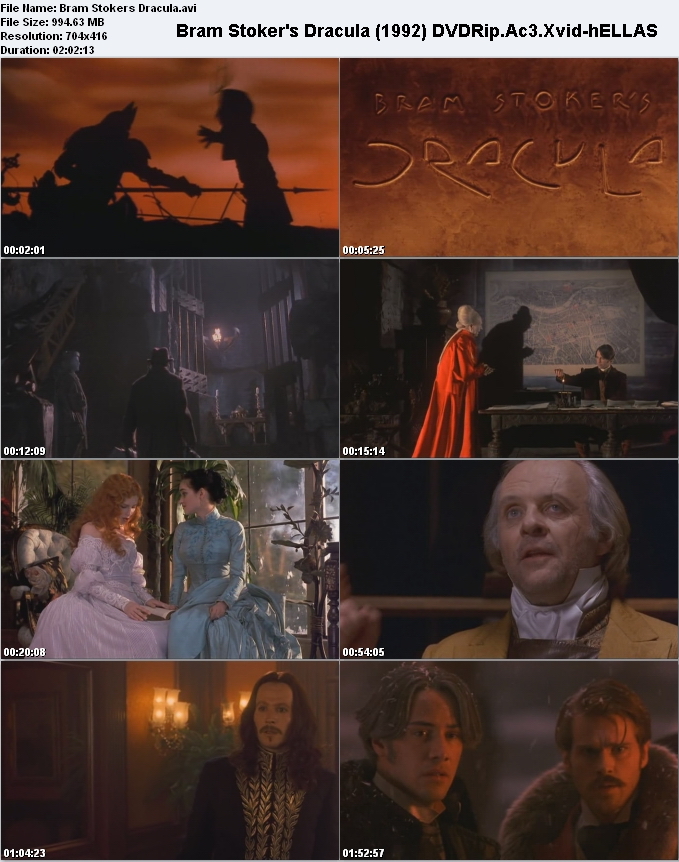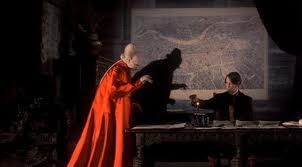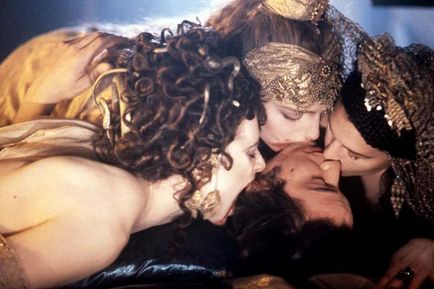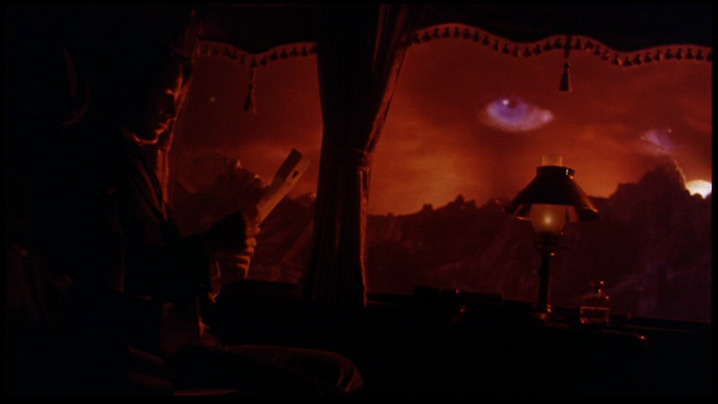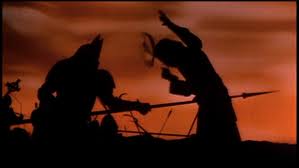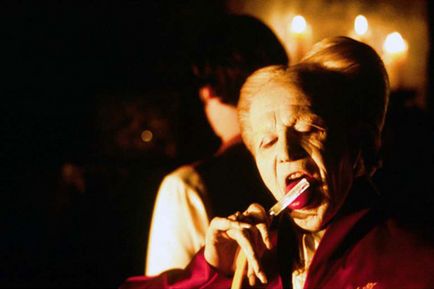From the Chicago Reader (November 27, 1992). I couldn’t (and wouldn’t) argue that this treat is necessarily Coppola’s best movie, for reasons given below, but I wonder if it might actually be his most pleasurable, at least on a moment-by-moment (and shot-by-shot) basis. The Blu-Ray only adds to and enhances the richness. — J.R.
BRAM STOKER’S DRACULA
*** (A must-see)
Directed by Francis Ford Coppola
Written by James V. Hart
With Gary Oldman, Winona Ryder, Sadie Frost, Tom Waits, Anthony Hopkins, Keanu Reeves, Richard E. Grant, Cary Elwes, and Bill Campbell.
Geographical spread accounts for some of the major differences between the film culture in this country and the various film cultures in Europe. While overseas the principal film-production centers and intellectual centers are usually located in the same cities — Paris, Rome, London, Madrid, Lisbon, Stockholm, Budapest, Prague — most of the United States stretches between our main film-production center, Hollywood and environs, and our main intellectual center, New York. The practical consequence is that our left hand hasn’t the faintest idea what our right hand is doing.
So much for the geographical split. What might be called the institutional gap is even worse. I’m referring to the profound lack of communication between the film industry (including most movie reviewers) and academic film studies (including intellectuals in adjacent or related fields). You want examples? Look at the collected reviews of Pauline Kael since the early 70s, when academic film study in the U.S. was just getting started, and you’ll be hard put to find a shred of evidence in more than two decades of energetic writing that such studies existed at all. Look at the reviews of nearly all her journalistic colleagues during the same period and the same absence is painfully apparent.
Consider that major European academics such as Umberto Eco and the late Roland Barthes have written about movies for popular newspapers and magazines, but their U.S. counterparts are considered much too esoteric for such exposure — which doesn’t mean that American readers are dumber, only that American editors (and perhaps writers) are more restrictive. Or consider that European TV stations think nothing of routinely programming series devoted to key Hollywood directors such as Samuel Fuller, Howard Hawks, Otto Preminger, and Douglas Sirk, but the very idea of Cinemax or the Movie Channel or American Movie Classics making such a highbrow gesture more than once in a blue moon would send shock waves through the industry. (I can’t imagine it bothering viewers; European TV watchers certainly haven’t been bothered, which is why these directors are much better known over there than here.) Similarly, when TV channels abroad show ‘Scope films in their original formats, a process known as letterboxing, the reasons are usually artistic. Here, the selection by cable channels of what to letterbox seems almost totally arbitrary (Pillow Talk but not The Tarnished Angels, for instance); this Sunday TNT is presenting a whole day of letterboxed movies, but the titles selected suggest that artistic considerations had little or nothing to do with the choices. Finally, while English movie reviewers on TV and in national newspapers periodically acknowledge the existence of academic film theory — almost exclusively, I should add, in order to jeer at it — here the possibility of it even being attacked in the national press seems well beyond the pale.
These reflections are inspired in part by some curious critical responses to Bram Stoker’s Dracula, by far Francis Coppola’s most European-influenced movie to date. These responses testify to the fact that we still have two autonomous film cultures that are barely on speaking terms. (As someone who has often tried to work in both worlds and occasionally served as an interpreter between them, I would add that the noncommunication goes both ways; some film professors are every bit as indifferent to the industry and to mainstream critics as these critics and the industry are to them.)
I could be wrong, but I’ll bet academic critics will have a field day with Coppola’s swarming, overpacked horror extravaganza once they have a chance to digest it. (I’d give them about half a year to nine months — roughly the time it takes for the movie to come out on video.) For one thing, it’s a movie that would benefit from excerpting and repeated viewings, two classroom standbys. For another, it seizes on all sorts of ideas that were kicking around certain film departments 10 or 15 years ago, such as the notion that movies and psychoanalysis got started around the same time (which makes Stoker’s 1897 novel contemporaneous with both), and concepts involving female desire, sexual hysteria, and hypnosis that were related to some of Freud’s early cases. (It may not be irrelevant that these ideas were au courant around the time Coppola’s Zoetrope studio in San Francisco was giving free office space to Camera Obscura, “A Journal of Feminism and Film Theory” that still comes out fairly regularly.)
Yet despite all this academic ripeness — and probably more concepts and allusions per square inch than any Coppola movie since Apocalypse Now — most mainstream reviewers have been suggesting that Bram Stoker’s Dracula is dull and bereft of ideas, or, in the case of Vincent Canby in the New York Times, celebrating it as a triumph of style with little meaning. On Siskel and Ebert’s TV show, where Ebert somewhat apologetically gave it a “thumbs up” because of how it looked, Siskel raked him over the coals for being so indulgent with such a boring and empty movie.
Boring? Empty? These adjectives accurately describe most Hollywood pictures I see week after week, all of which have easily definable heroes, plots, conflicts, and resolutions, and as few ideas of any kind as possible — visual, thematic, stylistic, or otherwise. If anything, Bram Stoker’s Dracula suffers from a surfeit of such ideas, not to mention a surfeit of characters and action. If you require your entertainments to be easy to follow and to synopsize or review afterward, you’d be better off heading for Aladdin.
Here’s a partial list of what you get in this postmodernist stew:
(1) Several alternating narrators, creating a somewhat dispersed narrative that eventually comes together only in relation to the love story (see number ten below).
(2) Subtitled Romanian dialogue. Along with the heavily accented voices of various narrators and characters, this goes a long way toward making this the most “Europeanized” of Coppola’s pictures. When an American character turns up — a quasi-comic Texan named Quincey P. Morris (Bill Campbell), one of the suitors of Lucy (Sadie Frost) — we’re certainly not encouraged to regard him as the hippest guy around, as we would in a “normal” American picture.
(3) Musings on early models of 20th-century technologies (including the typewriter and phonograph as well as the “cinematograph”) and on the relation of venereal diseases to culture (“syphilisation” is a key pun). Some reviewers have mentioned AIDS as an implicit thematic concern; maybe so, but I don’t see it, and I certainly don’t see the movie contributing any insights on the topic.
(4) Reflections on the purchase of real estate. “Why ten houses in such precise locations in London?” Jonathan Harker asks Dracula after he goes to Transylvania to visit him. “Is it to raise the market value?”
(5) Diverse blood rituals, spectacles, and allegories relating to Catholicism. A wedding is intercut with a bestial sexual ravishment, recalling the juxtapositions of baptism with murder in The Godfather; elsewhere, a vampire is repelled by a wafer used in the mass.
(6) Many fancy and often lovely superimpositions and various baroque visual transitions drawn from silent movies.
(7) Monsters that go through so many incarnations that at times it’s hard to be sure whether they’re the same characters — an ambiguity that increases the dispersed narrative effect. Dracula obviously holds the record in this regard, but other vampires in the movie are put through a significant number of changes as well.
(8) Multiple evocations of decadent European art in diverse forms, from turn-of-the-century writers Joris-Karl Huysmans and Oscar Wilde and artists Gustav Klimt and Aubrey Beardsley to present-day filmmakers Werner Schroeter (evoked especially in an arbor in Lucy’s garden that seems straight out of The Death of Maria Malibran) and Raul Ruiz (recalled in a few striking deep-focus, diptych compositions featuring letters and journals in the foreground and other details in the background).
(9) Countless borrowings from diverse examples of either German or German-influenced movie expressionism. This includes malignant city maps and eyes in the sky from early Fritz Lang, shadows from Arthur Robison’s Warning Shadows, multiple images from Murnau’s Faust (including rising rings of fire, rapid, subjectively framed nocturnal flights recalling the flight of Mephistopheles, and at least one of the demonic incarnations of Mephistopheles himself), silhouetted dancers behind frosted glass that seem straight out of Vampyr, an ingenue in a glass coffin from Snow White and the Seven Dwarfs, a set of dreamlike opening images clearly drawn from Citizen Kane‘s prologue, a woman rising erotically out of a poollike bed that might well have been suggested by Eraserhead, and Wagnerian vistas and cameos that occasionally suggest Hans-Jürgen Syberberg.
(10) Finally, smack dab in the middle of all this, a florid, romantic love story between Dracula (Gary Oldman) and Mina (Winona Ryder), complete with an orchestral theme evoking the movie scores of Miklos Rozsa. One should add that while the treatment of female sexuality as predatory (making all the female characters with the possible exception of Mina erotically interchangeable) is conventionally Victorian and therefore sexist, the generally positive treatment accorded to Mina’s sexuality, even when it intersects with vampiristic blood lust, might deserve the adjective “feminist.”
Of course it’s all too much — which makes one wonder why some reviewers are implying it isn’t nearly enough. One reason is that “too much” can be read as a symptom of too little when it comes to ideas. (The references to The Golden Bough and “The Hollow Men” in the pretentious final sequence of Apocalypse Now suggest, among other things, that Coppola was stuck for an ending.) Another is that an unwanted busyness and complexity can easily produce boredom, a lazy refusal to participate in the various games a screenwriter and director are proposing.
Perhaps the most important of these games is reverting to the four separate narrators of Bram Stoker’s novel rather than following the “objective” narration of the corny American stage adaptation of Hamilton Deane and John Balderston, which premiered 30 years after the novel’s publication and was the source of all the major film versions of Dracula, at least in English. (Coppola and screenwriter James V. Hart’s predecessor in this respect is Orson Welles, whose highly inventive 1938 radio adaptation of the novel, cowritten with John Houseman, was the first of his weekly hour-long Mercury shows, broadcast 17 weeks before The War of the Worlds.)
The relative difficulty of Bram Stoker’s Dracula provides an interesting riposte to the dubious evolutionary theory that claims art keeps getting more sophisticated and complex. While Jean-Luc Godard has pointedly remarked (I quote from memory) that we speak of seeing “old Griffith films” but not of reading “old” Dickens novels, the fact remains that Stoker’s story-telling method of using the letters, journals, and diary entries of four major characters and several minor ones — accessible enough to make his book a best-seller in 1897 — is still too difficult for some people in a movie 95 years later, even though Hart and Coppola offer a highly simplified version of his method. The main reason for this difficulty may be the absurd simplifications of most contemporary Hollywood movies, which generally depend on single identification figures and fairly unambiguous story lines, and therefore do nothing to prepare us for polyphonic movies like this.
I don’t mean to exclude myself from this problem, as I often have more than a little trouble following the idiot plots of “normal” movies. Thanks to what seemed like narrative overload the first time around, I was periodically disengaged from Bram Stoker’s Dracula as plot before getting pulled back again. But when I returned to the movie a couple of days later, I found nearly all of it easy to follow and realized how much of my difficulty came from the movie’s refusal to stick with a single protagonist and identification figure all the way through. I suspect that many of my colleagues grew impatient because Jonathan Harker (Keanu Reeves), who starts off like the hero in the first long sequence, becomes passive, then quite secondary to the narrative for increasingly long stretches, and by the end virtually irrelevant.
A triumph of studio filmmaking, Bram Stoker’s Dracula is so much a matter of lovely details (some isolated, some orchestrated) that it can certainly be accused of runaway formalism at times. Sometimes these details are loving re-creations — an evocation of jerky 1897 filmmaking in a bustling London street scene where Mina and Dracula first meet (and where a sandwich board advertises a Hamlet at the Lyceum with the famous actor Henry Irving, Stoker’s real-life employer and the principal model for Dracula). Sometimes they’re careful lab effects (a match dissolve from two teeth marks to pinpoints of light in a wolf’s eyes), and sometimes they’re beautifully crafted special effects (Dracula’s fangs at one point seem to grow before our eyes). As in Coppola’s Rumble Fish, images are indulged to the point where they often overtake their narrative pretexts; each patch of plot seems to be regarded as a canvas for visual improvisation and elaboration rather than thematic elucidation.
What you don’t get, by and large, are the narrative cohesion and continuity of a vampire classic like George Romero’s neglected Martin or even the chills most horror movies aim for. There are a few disturbing or at least offbeat details — Dracula shaving Harker’s neck from behind is a priceless eerie moment, and there are others nearly as good — but hardly any genuinely scary ones. The Count’s first Transylvanian appearance –with his hair in a double bun that’s the same general shape as Mickey Mouse’s ears, and his accent too reminiscent of Bela Lugosi’s — is so camplike that we can’t be seriously frightened by him afterward. Even when he offers his three erotic vampire brides a newborn baby to devour instead of Harker, one essentially feels he’s holding up his end of the bargain rather than cowing us with his ruthlessness. For spectators hoping to be frightened out of their wits, this is surely a flaw. But the film finds so many other ways of entertaining and provoking us that it’s forgivable, even in a vampire picture.

